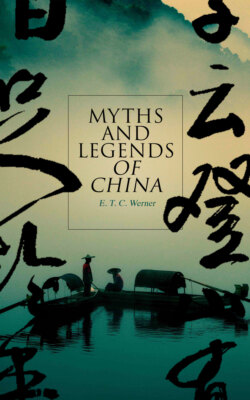Читать книгу Myths and Legends of China - E. T. C. Werner - Страница 59
На сайте Литреса книга снята с продажи.
The Fashioner of the Universe
ОглавлениеThe most conspicuous figure in Chinese cosmogony is P'an Ku. He it was who chiselled the universe out of Chaos. According to Chinese ideas, he was the offspring of the original dual powers of Nature, the yin and the yang (to be considered presently), which, having in some incomprehensible way produced him, set him the task of giving form to Chaos and "making the heavens and the earth."
Some accounts describe him as the actual creator of the universe—"the ancestor of Heaven and earth and all that live and move and have their being." 'P'an' means 'the shell of an egg,' and 'Ku' 'to secure,' 'solid,' referring to P'an Ku being hatched from out of Chaos and to his settling the arrangement of the causes to which his origin was due. The characters themselves may, however, mean nothing more than 'Researches into antiquity,' though some bolder translators have assigned to them the significance if not the literal sense of 'aboriginal abyss,' or the Babylonian Tiamat, 'the Deep.'
P'an Ku is pictured as a man of dwarfish stature clothed in bearskin, or merely in leaves or with an apron of leaves. He has two horns on his head. In his right hand he holds a hammer and in his left a chisel (sometimes these are reversed), the only implements he used in carrying out his great task. Other pictures show him attended in his labours by the four supernatural creatures—the unicorn, phoenix, tortoise, and dragon; others again with the sun in one hand and the moon in the other, some of the firstfruits of his stupendous labours. (The reason for these being there will be apparent presently.) His task occupied eighteen thousand years, during which he formed the sun, moon, and stars, the heavens and the earth, himself increasing in stature day by day, being daily six feet taller than the day before, until, his labours ended, he died that his works might live. His head became the mountains, his breath the wind and clouds, his voice the thunder, his limbs the four quarters of the earth, his blood the rivers, his flesh the soil, his beard the constellations, his skin and hair the herbs and trees, his teeth, bones, and marrow the metals, rocks, and precious stones, his sweat the rain, and the insects creeping over his body human beings, who thus had a lowlier origin even than the tears of Khepera in Egyptian cosmology. 3
This account of P'an Ku and his achievements is of Taoist origin. The Buddhists have given a somewhat different account of him, which is a late adaptation from the Taoist myth, and must not be mistaken for Buddhist cosmogony proper. 4
